How To Figure Out Your Draw Length. 7 Easy Ways to Measure Your Draw Length.
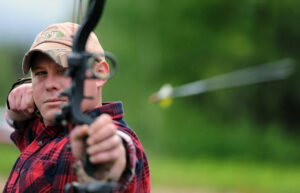
Learning how to figure out your draw length and properly setting up your bow is vital for accuracy.
Because even if we have a top of the line bow, you will never get the best out of it without the correct draw length, which helps your proper form.
Correct body structure in archery relies on having a consistent and comfortable anchor point that suits you. So being accurate has a lot to do with your ideal draw length.
Now we know how important the correct draw length is for accuracy, knowing how to measure your draw length is key for setting up your bow. Especially with a compound bow, were it has a set draw length, valley and wall. Were you can’t draw the bow too short or long from its fixed or adjustable set up.
With a recurve and longbow, the draw length is still very important, but the bow can be drawn from a wide range of draw lengths. The exception is for very short bows, or if you have a tall archer or long draw length. The bow will increase its poundage draw weight rapidly and be very hard to draw past a certain point. This is called stacking.
Recurves and longbow shooters should still measure their draw length too make sure it is suitable for a new bow. This also helps in working out the poundage for the bow as well or draw weight.
For an example, if the bows draw weight increases by two pounds for each inch (25mm.) they draw back. If the bow is rated at 40 lbs. at 28 inches, the archer might have a draw length of 26 inches, so they might only be shooting a 36 lbs. bow in draw weight.
Draw Length vs Arrow Length. Some measurement lengths in archery.
Before we get into learning how to figure out your draw length, let’s cover some archery terms and talk about the types of main measurement lengths in archery.
There is the bows draw length. The archers draw length and the arrows length. Click on, How To Measure An Arrow to find the correct arrow length.
(You might also include the length of the bow from tip to tip, or axle to axle, as another measurement.)
The difference between the bows draw length and the archer’s draw length is: A bow like a compound bow might be set up for, as an example at 29 inches. Click on How To Measure A Bows Draw Length for more information.
Most compounds are adjustable in draw length, but if it is set up for 29 inches, this means that anything outside of the length, give or take a bit will be impractical to shoot. Because of the mechanical design of the compound bow with wheels or cams, this creates a valley and wall.
An archer’s draw length is the physical draw length that suits him, or her precisely. (This will very a bit on type of shooting style they do. Such as compound with release aid. Shooting split finger, or three under with a recurve or longbow, etc.)
But the point is, the archer’s draw length is measurement that depends on the archer’s physical structure. Such as long or short arms, large or small torso, wide or narrow shoulders, etc.
To relate the two measurements together as above, an example might be: An archer, let’s call him John. John buys a compound bow from the pro shop. The bow is set up at the factory for a 29 inch draw length. However, John’s physical structure and shooting style means his correct draw length is 27 inches. Now to try and shoot a mechanical device that is set for 29 inches draw length and fit John’s physical draw length of 27 inches is not going to work.
Sure John can still shoot the bow. But he will be leaning back, over balancing and not using the correct back muscles. John will get a lot of high and low shots and he will wonder why accuracy sucks. John will probably give up archery, because it is too hard.
How to figure out your draw length. 7 ways to measure your draw length.
There are several ways to determine your draw length. However, these ways of finding your draw length are only a method to give you an initial starting figure. You can then refine your draw length from there.
1. Arm span divide 2.5 method & Draw Length Chart below.
The arm span method (or wing span method) is popular because it works reasonably well with most people, so it is a good starting point. Some archers say this method will get you spot on, or to within ½” of your correct draw length.
Calculating the arm span method.
The archer stands with their back against the wall. Both arms are the held out straight to the sides. (Like a “T” position.) Palms facing out.
Have some one measure in inches, your arm span fingertip to fingertip.
Once you have this number, divide by 2.5, this will be your approximate draw length.
(Below, down the very bottom of the page, is a draw length chart table to make it easy to determine your draw length.)
Arm span measuring tips.
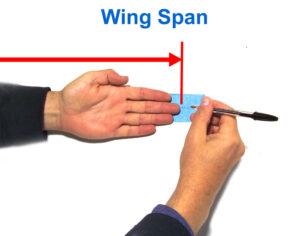
To make measuring easier, use two pieces of painters tape (So you don’t mark the walls.) and place them at the end of the finger tips. Now the archer can step away and the measurement taken.
Use this method, so you have a ball park figure for your draw length. Then get an experienced archer to help refine your draw length from there with a low poundage bow.
Some archers measure with the arm span method three times and then average out the results.
If you have no one to help measure your arm span, spread your arms out and position yourself with your finger tips on one hand against a corner of a wall (or at the end of some tape).
Whilst still leaving one hand finger tips in the exact place on the wall arm, take one arm away and twist around and with your free hand and mark the hand the end of the fingertips of the stationary hand. You can now step away and measure your arm span.
Here is as an example of the arm span divide 2.5 method.
The person’s wingspan is 70 inches wide. 70 ÷ 2.5 = 28.
So the archers draw length might be around 28 inches.
If the measurement comes up with, as an example 27.2, just round down or round up to the nearest 1/2 inch. Don’t get too hung up on the chart.
2. Arm span minus 15, divide 2.
This method is similar as above for measuring, but the formula is slightly different.
Have some one measure in inches, your arm span fingertip to fingertip. Take away 15 from this initial number, now divide by 2. This will be your approximate draw length.
Using the same example as above, the person’s wingspan is 70 inches wide. 70 – 15 = 55. 55 ÷ 2 = 27.5
So the calculation gives us a 27 ½ inch draw length for the archer.
Note this calculation is ½ inch different to the first one above. But is still gives us a ball park figure to work with.
3. Middle chest to wrist. How to figure out your draw length.
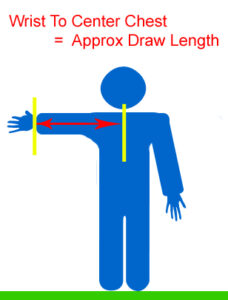
The third way is measuring from the center of your sternum to your wrist. (This method might also be called buttons to cuff or similar.)
Stand with your bow arm out to the side. The arm should be parallel to the floor. Have someone measure for the center of your chest, to your wrist.
I haven’t tried this on many people, so I can’t vouch for its accuracy. I tried it on myself and it got me within ½ inch of my draw length.
4. Fist against the wall method.

The archer stands in front of the wall. With their left arm (For a right handed archer.) they place their clenched fist flat against the wall.
Make sure that you are standing with your feet around shoulder width and straight up. Do not lean back or forwards too much.
The archer might have to creep forward or back, so they are standing straight with the fist touching the wall.
The archer will face their head towards the wall as well.
Now the measurement is taken from the wall to the archer’s right side of their mouth. (To the corner of the lips.)
One negative is the archer can extend their arm, shoulder and lock their elbow out giving and inch or so longer reading then ideally suited for their body.
5. How to measure draw length with an arrow. Drawing the bow and arrow method.
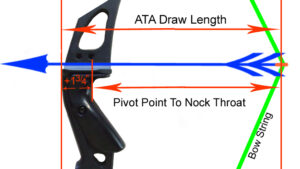
This is a good method to use. You are actually using the bow to figure out your draw length. However a couple of things can easily muck up the accuracy for this method.
If the bow used is way too heavy a draw weight for the archer, it won’t work well. As the person drawing back the bow will struggle and not pull the bow back as far as they should.
The second thing that might mess up the length is, if a compound bow is used. If the compound is not set ideally for the person draw length, it won’t work. As the peak weight, valley and wall of the compound draw cycle will only suit the draw length of what the bow is set at.
If you can adjust the draw length easily on the compound, then this is fine to use. Ensure the poundage is set low.
A third way this method won’t work is for an adult to try and use a children’s bow. A kids bow will stack, (Or break.) and won’t draw back any further.
Using a recurve bow or longbow is fine for this and could be a better way than using a compound bow. As long as the draw weight is very light.
If the archer is tall, make sure the longbow or recurve isn’t short and the bow doesn’t stack.
(Stacking means the draw weight suddenly increases as the limbs bend. This might be 29, 30 inches or more depending on the type, design and length of a bow. Low quality bows will probably stack more. Some short longbows and recurves might have this issue as well, depending on manufacturer.)
Ideally an experienced archer should check your form and see if everything looks correct. Ensure you are not leaning back or crunched up forward when at full draw.
The arrow you use can be marked with inch increments near the end. Or use tape and write on it.
We will use The ATA (Archery Trade Association.) to help determine our draw length.
The ATA standard draw length method is: To measure from the arrow nock groove on the bowstring to the pivot point of the grip, plus 1 3/4 inches. (For some bows, the pivot point is in line with the berger button hole.)
How to measure your draw length with an arrow. With a bit of tape on the bow making 1 ¾ inch past the pivot point of the grip to indicate this point, we draw back the arrow on the bow.
When we have a nice “T” posture at full draw, the arrow is marked by someone were it lines up with the ATA method. Or use the arrow marked already in increments.
If you are by yourself, take a picture of yourself at full draw. Use a timer on the camera or use video. (Safely with a safe target and backstop in case you accidentally release the arrow.) Make sure the image can capture the arrow length marks.
6. Arrow on chest.
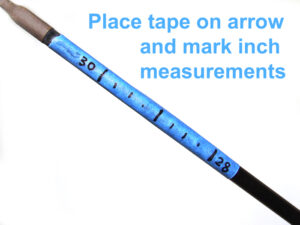
Another way to determine your draw length is to place an arrow on the center of your chest and reach out. The arms are extended out. Get someone to measure where your fingertips reach on the arrow.
Use a yard stick, (A long teacher’s ruler.) dowel, or an arrow marked with inch increments on it.
(If the arrow doesn’t mark easy, use masking tape on the arrow and mark that with a pen)
The negatives of this method are, you might bend your back, roll your shoulders forward, and stretch your arms too much. This will give an incorrect draw length measurement if you reach too far.
7. From neck and reach method.
This is similar method to the arrow on chest; however, the ruler is placed on the neck. Just above the collar bone and below the Adams apple. The archer then reaches out along the ruler and the measurement is taken at the outstretched finger tips.
A piece of dowel, broomstick or long ruler will work. Obviously be careful that no one bumps you doing this method and don’t use anything sharp on your neck. Safety first.
Just like the chest method you can overstretch and the measurement might be off.
Extra draw length information.
Once you do get your bow and archery gear set up, still try to refine your draw length as much as practical. This will help with accuracy immensely.
You might take some side on photos of you at full draw. (Make sure you are on level ground and not shooting uphill or down.) An experienced archer might look at the images to make sure your form and draw length is correct.
Another option is to post the image on an archery or bowhunting forum.
(Although some forums can get a bit wild and you might get some negative feedback. Other archers, while having your best interest in heart, might be eager to give you their advice, but their knowledge may be lacking.) Overall though, the archery forums have some very experience and wise archers.
Regardless of the critique, you should be reasonable standing straight up, without leaning backwards or forwards.
The bowstring should be at full draw around the corner of your lip. This will depending on your shooting discipline and preference. But basically it should be anchored solidly around your mouth, chin or check area.
As an example you might shoot bare bow with three under finger shooting, with a high anchor point, anchoring on your check. Check out How To Aim A Bow And Arrow for more information on aiming methods.
Or shooting an Olympic style target recurve with split fingers, anchoring low on the front or side of the chin.
Even with a compound bow and using a wrist style release aid device, anchoring your thumb on your neck / jaw bone, your bowstring should be around your lips. Most compound archers have too long of draw length, click on Correct Draw Length for some examples.
I am getting off track. But insure your anchor point is exact for you.
I would say along with the correct poundage draw weight bow, using and expanding the back muscles on release, the correct draw length and solid anchor is crucial for accuracy.
An expensive bow is useless, if the fundamentals of the correct draw length are wrong for you.
Always keep improving your form and the draw length is a vital element of this.
Conclusion. How to figure out your draw length.
Remember these ways of finding your draw length are only a method to get you an estimated figure.
You might even decide to do a couple of methods to get you in the ball park with a measurement. Maybe average the draw length results out, if you like tinkering.
Once you have a length, double check that it is correct for you and archery style.
Draw Length Chart. To help measure your draw length.
This chart uses the arm span divide 2.5 method to help determine your draw length without an arrow. This will get you in the ball park of your draw length.
Measure in inches your wing span, from finger tip to finger tip with your arms stretched out in a “T”. Once you have the measurement follow across the chart to get your approximate draw length. (Or divide your arm span by 2.5)
Round up or down to the nearest 1/2 inch.
| Arm Span | ÷ 2.5 | = | Draw Length
(Approximate) |
| 60 | ÷ 2.5 | = | 24 |
| 61 | ÷ 2.5 | = | 24.4 |
| 62 | ÷ 2.5 | = | 24.8 |
| 63 | ÷ 2.5 | = | 25.2 |
| 64 | ÷ 2.5 | = | 25.6 |
| 65 | ÷ 2.5 | = | 26 |
| 66 | ÷ 2.5 | = | 26.4 |
| 67 | ÷ 2.5 | = | 26.8 |
| 68 | ÷ 2.5 | = | 27.2 |
| 69 | ÷ 2.5 | = | 27.6 |
| 70 | ÷ 2.5 | = | 28 |
| 71 | ÷ 2.5 | = | 28.4 |
| 72 | ÷ 2.5 | = | 28.8 |
| 73 | ÷ 2.5 | = | 29.2 |
| 74 | ÷ 2.5 | = | 29.6 |
| 75 | ÷ 2.5 | = | 30 |
| 76 | ÷ 2.5 | = | 30.4 |
| 77 | ÷ 2.5 | = | 30.8 |
| 78 | ÷ 2.5 | = | 31.2 |
| 79 | ÷ 2.5 | = | 31.6 |
| 80 | ÷ 2.5 | = | 32 |

